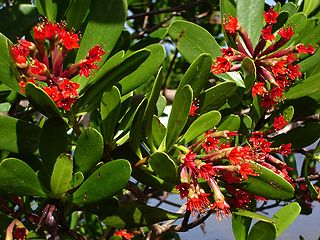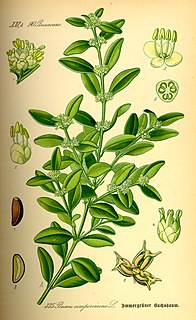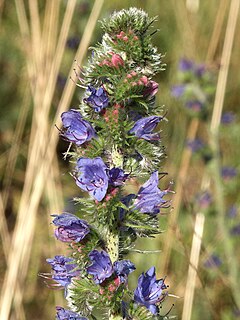Related Research Articles

The Myrtales are an order of flowering plants placed as a sister to the eurosids II clade as of the publishing of the Eucalyptus grandis genome in June 2014.

The Santalales are an order of flowering plants with a cosmopolitan distribution, but heavily concentrated in tropical and subtropical regions. It derives its name from its type genus Santalum (sandalwood). Mistletoe is the common name for a number of parasitic plants within the order.

Nepenthales is an order of carnivorous flowering plants in the Cronquist system of plant classification.

Dioscoreaceae is a family of monocotyledonous flowering plants, with about 715 known species in nine genera. The best-known member of the family is the yam.

Geraniales is a small order of flowering plants, included within the rosid subclade of eudicots. The largest family in the order is Geraniaceae with over 800 species. In addition, the order includes the smaller Francoaceae with about 40 species. Most Geraniales are herbaceous, but there are also shrubs and small trees.

The Buxales are a small order of eudicot flowering plants, recognized by the APG IV system of 2016. The order includes the family Buxaceae; the families Didymelaceae and Haptanthaceae may also be recognized or may be included in the Buxaceae. Many members of the order are evergreen shrubs or trees, although some are herbaceous perennials. They have separate "male" (staminate) and "female" (carpellate) flowers, mostly on the same plant. Some species are of economic importance either for the wood they produce or as ornamental plants.

Petrosaviaceae is a family of flowering plants belonging to a monotypic order, Petrosaviales. Petrosaviales are monocots, and are grouped within the lilioid monocots. Petrosaviales are a very small order of photosynthetic (Japonolirion) and rare leafless achlorophyllous, mycoheterotrophic plants (Petrosavia) found in dark montane rainforests in Japan, China, Southeast Asia and Borneo. They are characterised by having bracteate racemes, pedicellate flowers, six persistent tepals, septal nectaries, three almost distinct carpels, simultaneous microsporogenesis, monosulcate pollen, and follicular fruit.
The APG II system of plant classification is the second, now obsolete, version of a modern, mostly molecular-based, system of plant taxonomy that was published in April 2003 by the Angiosperm Phylogeny Group. It was a revision of the first APG system, published in 1998, and was superseded in 2009 by a further revision, the APG III system.
A system of plant taxonomy, the Takhtajan system of plant classification was published by Armen Takhtajan, in several versions from the 1950s onwards. It is usually compared to the Cronquist system. It admits paraphyletic groups.

Dasypogonaceae is a family of flowering plants, one that has not been commonly recognized by taxonomists; the plants it contains were usually included in the family Xanthorrhoeaceae. If valid, Dasypogonaceae includes four genera with 16 species.

The Rapateaceae are a family of flowering plants. The botanical name has been recognized by most taxonomists.

Boraginales is an order of flowering plants in the asterid clade. It includes the Boraginaceae and a number of other families, with a total of about 125 genera and 2,700 species. Its herbs, shrubs, trees and lianas (vines) have a worldwide distribution.

Loasaceae is a family of 15–20 genera and about 200–260 species of flowering plants in the order Cornales, native to the Americas and Africa. Members of the family include annual, biennial and perennial herbaceous plants, and a few shrubs and small trees. Members of the subfamily Loasoideae are known to exhibit rapid thigmonastic stamen movement when pollinators are present.

Magnoliidae is a subclass of Equisetopsida in the sense used by Mark W. Chase and James L. Reveal in their 2009 article "A phylogenetic classification of the land plants to accompany APG III." This subclass comprises the angiosperms or flowering plants.

The Aptandraceae is a family of flowering plants in the sandalwood order Santalales that is recognized by some sources; others sink the family in Olacaceae. The members of the tropical plant family are parasitic on other plants, usually on the roots, and grow as trees, shrubs or woody lianas.
The APG IV system of flowering plant classification is the fourth version of a modern, mostly molecular-based, system of plant taxonomy for flowering plants (angiosperms) being developed by the Angiosperm Phylogeny Group (APG). It was published in 2016, seven years after its predecessor the APG III system was published in 2009, and 18 years after the first APG system was published in 1998. In 2009, a linear arrangement of the system was published separately; the APG IV paper includes such an arrangement, cross-referenced to the 2009 one.
The Pteridophyte Phylogeny Group, or PPG, is an informal international group of systematic botanists who collaborate to establish a consensus on the classification of pteridophytes that reflects knowledge about plant relationships discovered through phylogenetic studies. In 2016, the group published a classification for extant pteridophytes, termed "PPG I". The paper had 94 authors.
References
- 1 2 3 Angiosperm Phylogeny Group (2009), "An update of the Angiosperm Phylogeny Group classification for the orders and families of flowering plants: APG III", Botanical Journal of the Linnean Society, 161 (2): 105–121, doi: 10.1111/j.1095-8339.2009.00996.x
- ↑ As easy as APG III - Scientists revise the system of classifying flowering plants, The Linnean Society of London, 2009-10-08, retrieved 2009-10-29
- ↑ APG III tidies up plant family tree, Horticulture Week, 2009-10-08, retrieved 2009-10-29
- ↑ Chase, Mark W. & Reveal, James L. (2009), "A phylogenetic classification of the land plants to accompany APG III", Botanical Journal of the Linnean Society, 161 (2): 122–127, doi: 10.1111/j.1095-8339.2009.01002.x
- ↑ Haston, E., Richardson, J.E., Stevens, P.F., Chase, M.W., Harris, D.J. (2009) The Linear Angiosperm Phylogeny Group (LAPG) III: a linear sequence of the families in APG III. Botanical Journal of the Linnean Society161, 128–131.
- ↑ Christenhusz, M. J. M., M. F. Fay, J. J. Clarkson, P. Gasson, J. Morales Can, J. B. Jimenez Barrios & M. W. Chase (2010). Petenaeaceae, a new angiosperm family in Huerteales with a distant relationship to Gerrardina (Gerrardinaceae), Botanical Journal of the Linnean Society 164: 16-25. http://onlinelibrary.wiley.com/doi/10.1111/j.1095-8339.2010.01074.x/abstract
- ↑ Christenhusz, M. J. M., M. W. Chase, & M.F.Fay (2011). Preface to "Linear sequence, classification, synonymy, and bibliography of vascular plants: Lycophytes, ferns, gymnosperms and angiosperms", Phytotaxa 19: 4–6. http://www.mapress.com/phytotaxa/content/2011/f/pt00019p006.pdf
- ↑ Chase, M.W.; Reveal, J.L. & Fay, M.F. (2009), "A subfamilial classification for the expanded asparagalean families Amaryllidaceae, Asparagaceae and Xanthorrhoeaceae", Botanical Journal of the Linnean Society, 161 (2): 132–136, doi: 10.1111/j.1095-8339.2009.00999.x